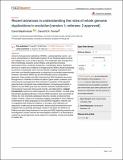Files in this item
Recent advances in understanding the roles of whole genome duplications in evolution
Item metadata
| dc.contributor.author | MacKintosh, Carol | |
| dc.contributor.author | Ferrier, David E. K. | |
| dc.date.accessioned | 2017-09-04T10:30:11Z | |
| dc.date.available | 2017-09-04T10:30:11Z | |
| dc.date.issued | 2017-08-31 | |
| dc.identifier | 250980312 | |
| dc.identifier | 1fbb4af9-37a6-47dc-afb6-9be875364d70 | |
| dc.identifier.citation | MacKintosh , C & Ferrier , D E K 2017 , ' Recent advances in understanding the roles of whole genome duplications in evolution ' , F1000Research , vol. 2017 , no. 6 , 1623 . https://doi.org/10.12688/f1000research.11792.1 | en |
| dc.identifier.issn | 2046-1402 | |
| dc.identifier.uri | https://hdl.handle.net/10023/11607 | |
| dc.description.abstract | Ancient whole-genome duplications (WGDs)—paleopolyploidy events—are key to solving Darwin’s ‘abominable mystery’ of how flowering plants evolved and radiated into a rich variety of species. The vertebrates also emerged from their invertebrate ancestors via two WGDs, and genomes of diverse gymnosperm trees, unicellular eukaryotes, invertebrates, fishes, amphibians and even a rodent carry evidence of lineage-specific WGDs. Modern polyploidy is common in eukaryotes, and it can be induced, enabling mechanisms and short-term cost-benefit assessments of polyploidy to be studied experimentally. However, the ancient WGDs can be reconstructed only by comparative genomics: these studies are difficult because the DNA duplicates have been through tens or hundreds of millions of years of gene losses, mutations, and chromosomal rearrangements that culminate in resolution of the polyploid genomes back into diploid ones (rediploidisation). Intriguing asymmetries in patterns of post-WGD gene loss and retention between duplicated sets of chromosomes have been discovered recently, and elaborations of signal transduction systems are lasting legacies from several WGDs. The data imply that simpler signalling pathways in the pre-WGD ancestors were converted via WGDs into multi-stranded parallelised networks. Genetic and biochemical studies in plants, yeasts and vertebrates suggest a paradigm in which different combinations of sister paralogues in the post-WGD regulatory networks are co-regulated under different conditions. In principle, such networks can respond to a wide array of environmental, sensory and hormonal stimuli and integrate them to generate phenotypic variety in cell types and behaviours. Patterns are also being discerned in how the post-WGD signalling networks are reconfigured in human cancers and neurological conditions. It is fascinating to unpick how ancient genomic events impact on complexity, variety and disease in modern life. | |
| dc.format.extent | 1026581 | |
| dc.language.iso | eng | |
| dc.relation.ispartof | F1000Research | en |
| dc.subject | QH301 Biology | en |
| dc.subject | QH426 Genetics | en |
| dc.subject | SDG 3 - Good Health and Well-being | en |
| dc.subject.lcc | QH301 | en |
| dc.subject.lcc | QH426 | en |
| dc.title | Recent advances in understanding the roles of whole genome duplications in evolution | en |
| dc.type | Journal item | en |
| dc.contributor.institution | University of St Andrews. School of Biology | en |
| dc.contributor.institution | University of St Andrews. Marine Alliance for Science & Technology Scotland | en |
| dc.contributor.institution | University of St Andrews. Scottish Oceans Institute | en |
| dc.identifier.doi | https://doi.org/10.12688/f1000research.11792.1 | |
| dc.description.status | Peer reviewed | en |
| dc.identifier.url | https://f1000research.com/articles/6-1623/v1 | en |
This item appears in the following Collection(s)
Items in the St Andrews Research Repository are protected by copyright, with all rights reserved, unless otherwise indicated.

